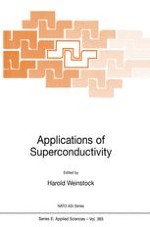
2000 | OriginalPaper | Buchkapitel
Low- and High-Tc Squids and Some Applications
verfasst von : John Clarke
Erschienen in: Applications of Superconductivity
Verlag: Springer Netherlands
Enthalten in: Professional Book Archive
Aktivieren Sie unsere intelligente Suche, um passende Fachinhalte oder Patente zu finden.
Wählen Sie Textabschnitte aus um mit Künstlicher Intelligenz passenden Patente zu finden. powered by
Markieren Sie Textabschnitte, um KI-gestützt weitere passende Inhalte zu finden. powered by
DC Superconducting QUantum Interference Devices are routinely fabricated from Nb films with an integrated input coil to couple in magnetic flux from the signal source. Typical dc SQUIDs operated at 4.2 K have a magnetic flux noise of 10−6 Φ0 Hz−1/2, where Φ0 is the flux quantum, corresponding to a magnetic noise energy of 10−32 JHz−1. With the aid of a superconducting flux transformer the magnetic field noise can approach 1 fT Hz−1/2. High-Tc dc SQUIDs fabricated from thin films of YBa2Cu3O7-x (YBCO) have achieved noise energies below 10−30 JHz−1 at 77 K and, with multilayer flux transformers, a magnetic field noise below 10 fT Hz−1/2 at frequencies down to a few Hz. An rf SQUID made from YBCO and operated at 77 K at frequencies around 1 GHz has achieved a magnetic field noise of 16 fT Hz−1/2 at frequencies above 100 Hz. A recent theory for rf SQUIDs predicts noise levels in good agreement with experiment. Two issues relevant to the operation of high-Tc SQUIDs in an unshielded environment are the increase in low-frequency noise arising from the entry of flux vortices into the YBCO films and the realization of long-baseline gradiometers. The applications of low-Tc SQUIDs to nuclear magnetic and nuclear quadrupole resonance, and of high-Tc SQUIDs to scanning SQUID microscopy and geophysics are discussed.